35mm cameras


- Edixa Reflex, with Steinheil Quinon 1.9/55mm, Isco Travegar 2.8/50mm
- Edixa-MAT REFLEX
- Edixa REX TTL
- Universal edixamat cd
- Edixa Stereo
- Edixa Electronica
- Edixa motoric
Edixa is a brand of camera manufacturer Wirgin Kamerawerk which was based in Wiesbaden, West Germany. The product line included several 35mm cameras and 16mm Edixa 16 subminiature cameras designed by Heinz Waaske from the 1950s to the 1970s.


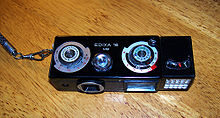
| subminiature camera | weight | dimension | lens | aperture | shutter | |
|---|---|---|---|---|---|---|
| 1 | Edixa 16 | 200g | 108x41x33mm | 25mm f/2.8 TRAGEVAR | 2.8 - 16 | 1/30 - 1/150 |
| 2 | Edixa 16M | 200g | 108x41x33mm | 25mm f/2.8 SCHNEIDER XENAR | 2.8 - 16 | 1/30 - 1/150 |
| 3 | Edixa 16MB | 200g | 108x41x33mm | 25mm f/2.8 SCHNEIDER XENAR | 2.8 - 16 | 1/30 - 1/150 |
| 4 | Edixa 16U | 200g | 108x41x33mm | 25mm f/2.8 SCHNEIDER XENAR | 2.8 - 16 | 1/30 - 1/150 |
| 5 | Franka 16 | 200g | 108x41x33mm | 25mm f/2.8 TRAGEVAR | 2.8 - 16 | 1/30 - 1/150 |
| 5 | alka 16 | 200g | 108x41x33mm | 25mm f/2.8 RODENSTOCK TRINAR | 2.8 - 16 | 1/30 - 1/150 |

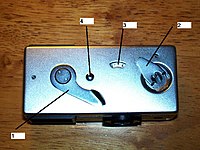


Edixa 16mm uses Rollei 16 type RADA cartridge, loaded with unperforated 16mm film, film width 16mm, frame format 14x21mm, 20 exposures per cartridge.

A twin-lens reflex camera (TLR) is a type of camera with two objective lenses of the same focal length. One of the lenses is the photographic objective or "taking lens", while the other is used for the viewfinder system, which is usually viewed from above at waist level.
Robot was a German imaging company known originally for clockwork cameras, later producing surveillance (Traffipax) and bank security cameras. Originally created in 1934 as a brand of Otto Berning, it became part of the Jenoptik group of optical companies in 1999, and specializes in traffic surveillance today.
The Instamatic is a series of inexpensive, easy-to-load 126 and 110 cameras made by Kodak beginning in 1963. The Instamatic was immensely successful, introducing a generation to low-cost photography and spawning numerous imitators.
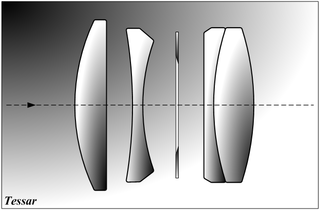
The Tessar is a photographic lens design conceived by the German physicist Dr. Paul Rudolph in 1902 while he worked at the Zeiss optical company and patented by Zeiss in Germany; the lens type is usually known as the ZeissTessar. Since its introduction, millions of Tessar and Tessar-derived lenses have been manufactured by Zeiss and other manufacturers, and are still produced as excellent intermediate aperture lenses.

Rollei was a German manufacturer of optical instruments founded in 1920 by Paul Franke and Reinhold Heidecke in Braunschweig, Lower Saxony, and maker of the Rolleiflex and Rolleicord series of cameras. Later products included specialty and nostalgic type films for the photo hobbyist market.
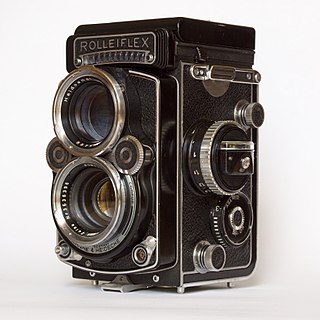
Rolleiflex is the name of a long-running and diverse line of high-end cameras originally made by the German company Franke & Heidecke, and later Rollei-Werke.

Jos. Schneider Optische Werke GmbH is a manufacturer of industrial and photographic optics. The company was founded on 18 January 1913 by Joseph Schneider as Optische Anstalt Jos. Schneider & Co. at Bad Kreuznach in Germany. The company changed its name to Jos. Schneider & Co., Optische Werke, Kreuznach in 1922, and to the current Jos. Schneider Optische Werke GmbH in 1998.

The Rolleiflex SL35 is a range of SLR cameras manufactured and sold by the German camera maker Rollei from 1970 to 1982. This range of cameras uses 35mm film. The camera bodies were initially made in Germany. After Zeiss Ikon discontinued camera production, Rollei acquired the Voigtländer brand and camera designs in 1972, and began producing a second generation of SLR cameras in Singapore starting from 1976. Some of those second-generation cameras were rebranded and marketed as Voigtländer VSL.

Minolta 16 refers to a line of 16mm subminiature cameras made by Minolta between 1955 and 1974. The negative size was 10x14 mm for the earlier models, later, a larger format, 12x17 mm was adopted, using single-perforated 16 mm film. It was possible to load your own cassettes, and also develop the film using a special developing tank with a spiral insert for 16 mm film.

Retina was the brand-name of a long-running series of German-built Kodak 35mm cameras, produced from 1934 until 1969. Kodak Retina cameras were manufactured in Stuttgart-Wangen by the Kodak AG Dr. Nagel Werk which Kodak had acquired in December 1931.

The Rollei 35 is a 35mm miniature viewfinder camera built by Rollei. The original Rollei 35, when introduced at photokina in 1966, was the smallest existing 135 film camera. The Rollei 35 series remains one of the smallest 35 mm cameras after the Minox 35 and Minolta TC-1. In 30 years, about 2 million Rollei 35 series cameras were manufactured. The Rollei 35 was manufactured by DHW Fototechnik up to 2015, the successor of Franke & Heidecke as small-batch production. The last version is the Rollei 35 Classic, an updated Rollei 35 SE.
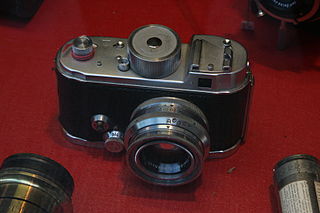
The Robot II was a mechanical 135 film camera by Robot introduced in 1938. It was a slightly larger camera than the Robot I, with some significant improvements but still using the basic mechanism. Among the standard objectives were 3 cm Zeiss Tessar and a 33⁄4 cm Zeiss Tessar in 1:2,8 and 1:3,5 variations, a 1:2,0/40 mm Zeiss Biotar and 1:4/7,5 cm Zeiss Sonnar.

The Contaflex series is a family of 35mm Single-lens reflex cameras (SLR) equipped with a leaf shutter, produced by Zeiss Ikon in the 1950s and 1960s. The name was first used by Zeiss Ikon in 1935 for a 35mm Twin-lens reflex camera, the Contaflex TLR; for the earlier TLR, the -flex suffix referred to the integral reflex mirror for the viewfinder. The first SLR models, the Contaflex I and II have fixed lenses, while the later models have interchangeable lenses; eventually the Contaflexes became a camera system with a wide variety of accessories.

Heinz Waaske was a German camera designer, notably father of the Rollei 35.

Wirgin was a German company which is still known for its brands Wirgin and Edixa, and for its camera types like the Edina, the Edinex or the Gewirette. It was based in the Hessian capital Wiesbaden and made a line of quite inexpensive 35mm SLRs from the 1950s to the 1970s, including the Edixa Reflex and Edixa-Mat Reflex. Wirgin was West Germany's main producer of SLRs with focal plane shutter. It also produced some of the lenses for its cameras, among them several M42 screw mount lenses.

The Kodak Retina Reflex is a discontinued series of four single-lens reflex cameras made by Kodak in Germany between 1957 and 1974, as part of the Kodak Retina line of 35mm film cameras.

The Kine Exakta was the first 35mm single-lens reflex (SLR) still camera in regular production. It was presented by Ihagee Kamerawerk Steenbergen GmbH, Dresden at the Leipziger Frühjahrsmesse in March 1936. The Exakta name had already been used by Ihagee on a roll film rangefinder RF camera line since 1933, among these the Vest Pocket Exakta Model B from which the Kine Exakta inherited its general layout and appearance. The word Kine never appeared on the camera itself, only in the instruction manuals and advertising to distinguish it from the roll film variants. Several of its features constituted the foundation for the majority of 35mm SLR cameras produced ever since, although at this stage in a relatively primitive state.

Kamera-Werkstätten Guthe & Thorsch (K.W.) was established 1919 in Dresden by Paul Guthe and Benno Thorsch, starting out manufacturing the Patent Etui plate camera. Ten years later came the roll film TLR Pilot Reflex and in 1936, the 6×6 SLR Pilot range. By that time, Benno Thorsch, the surviving partner from 1919, decided to immigrate to the United States and arranged with the US citizen Charles Noble to swap enterprises. Noble came to Germany and moved the factory to Niedersedlitz on the outskirts of Dresden, while Benno Thorsch in Detroit ran the acquired photo finishing business that was one of the largest in the USA. The new Kamera-Werkstätten AG, Niedersedlitz prospered, and in 1939 launched the 35mm SLR Praktiflex camera. The concept proved successful, and through continuous development, the Praktica name became one of the most popular 35mm SLR brands for several decades, beginning in the 1950s.

The Arriflex 16ST, also Arriflex 16S, is a 16mm MOS production motion picture camera released in 1952 by ARRI. The camera utilizes a voltage of 8.4 volts DC

Friedrich Deckel GmbH, also known as F.Deckel, was a German company founded by Friedrich Deckel and Christian Bruns in Munich as Bruns & Deckel in 1903. Its most famous product is the Compur line of leaf shutters used on many photographic lenses starting from 1911. Bruns and Deckel previously had worked together at C. A. Steinheil & Söhne; Bruns was an inventor responsible for developing leaf shutters while Deckel was a laboratory mechanic.